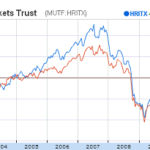If 2012 was the year of the dividend ETF, 2013 may be the year of the low volatility ETF. Â The dividend play may be a bit skewed going into 2013 due to so many special dividends (here are a few special dividend announcements) being paid prior to year-end and a possible exodus from dividend payers with dividend tax rates set to triple. At first glance, these two strategies should be vastly similar. Dividend stocks tend to offer lower volatility and juiced returns.
As I looked into backtesting data on low volatility strategies, I was surprised at what I found. Low volatility strategies have an uncanny ability to seemingly avoid every major burst at the most opportune time.
Here’s a chart from S&P Indices showing the sectors that the S&P Low Volatility (SPLV) would hold if the same strategy were deployed in the last 20 years:

Take notice to how the fund cut energy exposure to zero in 2005-2006 before the oil bubble burst, cut financial exposure before the financial crisis of 2008, and how well it called health care’s bull run right as Obamacare became reality.
The last few years for this fund have been truly remarkable, although the fund has been just as successful in years that start with nineteen, too.
Low Volatility Performance
Backtesting the strategy behind the S&P Low Volatility ETF (SPLV) reveals very interesting results: the 100 lowest volatility stocks in the S&P 500 performed better than the S&P 500 index as a whole from 1991 to 2011. Given that the backtested results, this strategy generates incredible alpha. Here’s a chart:

We have to determine why this strategy is so successful if we’re willing to label it investable.
Low beta securities are those that wiggle just a little less than your average stock. Thinking simply about efficient market hypothesis, we’d believe that more volatility is correlated with greater risk. If the market ascribes relatively the same value over and over again to the same security day after day (creating a low beta), chances are good that Wall Street has a good idea about how it should be valued. If instead the market ascribes wildly different values day after day to the same security, then it should be concluded that the market has very little understanding of how to value it.
If 10 appraisers give the same value to your home day after day, clearly there is a good way to value it. If in the next week 10 appraisers give vastly different values, something may have fundamentally changed in their ability to assign a value to your home.
The strategy of the S&P Low Volatility ETF (SPLV) seems to play this perfectly. The ETF tracks an index which owns the least volatile 100 stocks in the S&P 500 index based on trailing 12 month volatility. When volatility in a sector goes up, this ETF starts cutting back. That is to say that when Wall Street starts giving signs of its inability to justify its valuations, this low volatility strategy gets out of the way; it allocates money elsewhere. Based on historical performance, it seems to have done a really good job of getting out of the way right before catastrophe strikes. Outperformance from this fund isn’t from higher returns in the good years, but much lower losses in the bad years.
Why Low Volatility ETFs Aren’t Just a Ploy
It’s been said that low volatility funds are just capturing AUM at a good for their marketing departments, a period in which investors hear the word “volatility†over and over again on CNBC despite the fact that volatility, at least according to the VIX, is nearing historic lows.
When investors think low volatility they usually think fixed-income assets of short-to-medium duration. That was a good play in 1997, but a poor play in 2012.
Low volatility stocks seem to have just as much merit as bond funds without all the inflation risk that investors have to tolerate at the present time (given the fiscal cliff and another potential US downgrade, shorting Treasuries may be the play of 2013). If inflation rises and rates rise in response, bond funds get clobbered by convexity. If inflation rises, the case can be made that high-quality equities can pass the rising costs onto customers, improving earnings sufficiently to negate the effects of inflationary pressures in the discount rate used to value the company.
Bottom line: Consider low volatility ETFs with a backtested track record like the S&P Low Volatility ETF (SPLV) to be a hedge against retiring at the wrong time, a time when bond yields are unsustainably low or, as we saw in 2008, the economy is on the brink of collapse. If given the choice to move up the risk curve to avoid low yields in bonds, this would be my favorite way to make that play. The low .25% annual expense, diversification between 100 high-quality stocks, and dividend yield nearing 3% makes this fund a winner.
Disclosure: No position in any tickers mentioned here.











{ 0 comments… add one now }